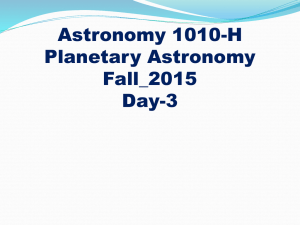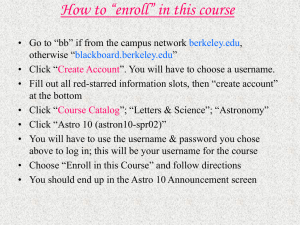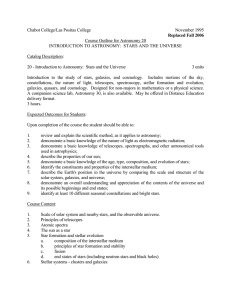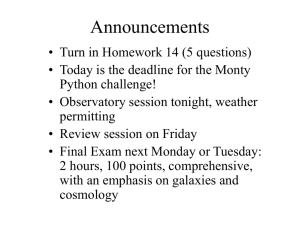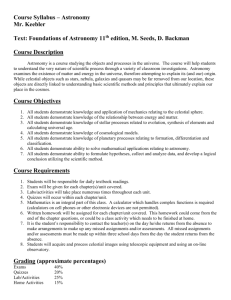Astronomy Reading Guide Our Place in the Universe
advertisement
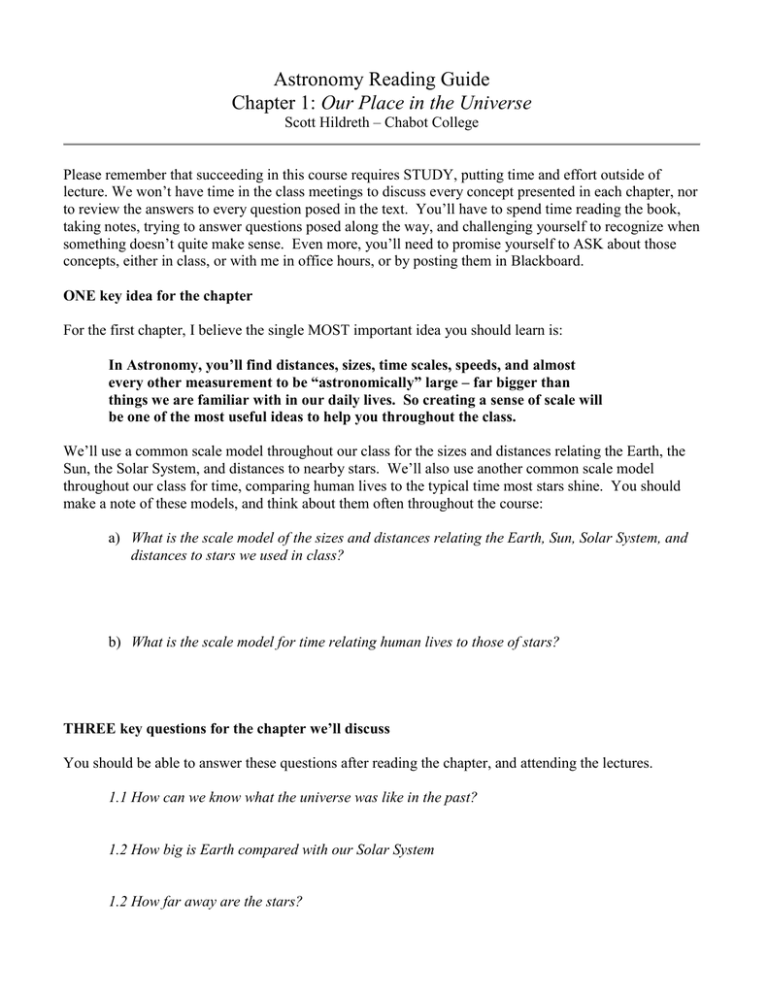
Astronomy Reading Guide Chapter 1: Our Place in the Universe Scott Hildreth – Chabot College Please remember that succeeding in this course requires STUDY, putting time and effort outside of lecture. We won’t have time in the class meetings to discuss every concept presented in each chapter, nor to review the answers to every question posed in the text. You’ll have to spend time reading the book, taking notes, trying to answer questions posed along the way, and challenging yourself to recognize when something doesn’t quite make sense. Even more, you’ll need to promise yourself to ASK about those concepts, either in class, or with me in office hours, or by posting them in Blackboard. ONE key idea for the chapter For the first chapter, I believe the single MOST important idea you should learn is: In Astronomy, you’ll find distances, sizes, time scales, speeds, and almost every other measurement to be “astronomically” large – far bigger than things we are familiar with in our daily lives. So creating a sense of scale will be one of the most useful ideas to help you throughout the class. We’ll use a common scale model throughout our class for the sizes and distances relating the Earth, the Sun, the Solar System, and distances to nearby stars. We’ll also use another common scale model throughout our class for time, comparing human lives to the typical time most stars shine. You should make a note of these models, and think about them often throughout the course: a) What is the scale model of the sizes and distances relating the Earth, Sun, Solar System, and distances to stars we used in class? b) What is the scale model for time relating human lives to those of stars? THREE key questions for the chapter we’ll discuss You should be able to answer these questions after reading the chapter, and attending the lectures. 1.1 How can we know what the universe was like in the past? 1.2 How big is Earth compared with our Solar System 1.2 How far away are the stars? FIVE key passages, pages, pictures, and paragraphs you should review In your study of this chapter, be sure to spend extra time on the following areas, re-reading them and thinking about them. Come back to these five ideas first when you study for the exams. 1. Page 3 - Figure 1.1 – Our cosmic address. Note this isn’t to scale, but it does quickly capture the relationships of classes of some objects in the universe, from planets to solar systems to stars to galaxies to clusters. 2. Page 5 – Basic Astronomical Objects, Units, and Motions. A list of key vocabulary you’ll encounter in our class. Familiarize yourself with all of these. 3. Pages 8-9 – How can we know what the universe was like in the past? This passage discusses one of the most important ideas in our entire class. Look carefully at figures 1.3 and 1.4 and the “Think About It” passage. 4. Pages 10-15 – Section 1.2 – The Scale of the Universe. This entire section will help you with the most important concept of the chapter, and with two of the three key ideas mentioned above. You might consider sketching out your own version of the chart on page 11 using the walk we took at Chabot for our scale of the solar system. (Note we used a slightly smaller object, a nerf ball, for our Sun, than the grapefruit in the textbook model. So our scale is a bit smaller.) 5. Page 20 – Figure 1.16 – The basic motions of the Earth in the Universe. A neat small visual summary of all of the motions discussed in section 1.3 Five key end-of chapter resources you should look at Pages 21 – 22 - The Big Picture & Chapter Summary of Key Concepts Review Questions Does it make sense? Quick Quiz Process of Science Many of these exact questions will be used in the chapter reading quiz, and online homework at Mastering Astronomy, and some may appear on the midterm exam. Make a note below of the concepts and questions you are not sure you understand, or that you want additional help with. Show me these before/after class, ask them in class, or post them in Blackboard. Questions/Concepts To Review:

